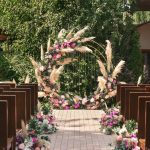Woodworking has been an important part of Moroccan culture for a long time. People use woodworking in religious ceremonies and consider it a form of worship. Skilled artisans create beautiful wooden structures for homes, mosques, churches, temples, and shrines. These structures show respect and devotion to God. When we understand the effort put into making each piece, we can appreciate its value.
Historical Significance
For centuries, Moroccan woodworking has been important for rituals, culture, and symbols. Generations pass down the tools used to make furniture and sculptures. It takes a lot of skill and time to create these intricate pieces. Each one tells a story and represents our beliefs and history. They help us stay connected to our past and look forward to the future.
Symbolic Representation
Moroccan woodworking is interesting, especially when it’s used for religious ceremonies. The artisans make carvings and designs that have special meanings and honor their faith. It’s amazing how they’ve been using woodworking for a long time to show their spirituality.
Wood Carvings
People in Morocco have been using woodworking techniques for a long time to make beautiful and special things. From carvings to furniture, artisans express their beliefs and values through their work. These creations are not only decorations but a way to share stories and pass on traditions to future generations.
Religious Iconography
As a Moroccan woodworking expert, I know how important religious symbols are in my craft. I use special designs and patterns that represent rituals and traditions. These symbols make the artwork feel spiritual and meaningful. So proud to share our stories through my work and keep them alive for the future.
Intricate Carvings
Moroccan woodworking is like making beautiful artwork using traditional styles and cultural influences.
Talented craftsmen carve detailed designs into hardwoods. This creates amazing pieces for religious ceremonies and special occasions.
They weave detailed motifs, such as flowers and geometric patterns, into panels, doors, and items used in temples and mosques.
Each crafted piece tells a unique story and reflects devotion and respect for tradition.
The attention to detail is amazing, with fine lines and intricate designs that carry deep meanings.
These talented woodworkers use small chisels to shape complex forms and polish them until they shine.
Every creation is a piece of history that showcases Morocco’s rich culture.
Next, let’s talk about the incredible hand-crafted furniture they make using the same level of skill.
Hand-Crafted Furniture
Moroccan woodworking is not only about carving but creating beautiful furniture too. This furniture has a special role in religious ceremonies and is part of Morocco’s culture.
Talented woodworkers in Morocco use old-fashioned methods to create special furniture. This shows the country’s style and culture. They use cool shapes, fancy designs, and natural wood like cedar and teak. They even add shiny mother-of-pearl for extra decoration. These special pieces of furniture make homes and places of worship look beautiful and unique. These pieces make homes and mosques look grand and elegant, carrying on traditions for generations to appreciate them.
The legacy continues! Now let’s see how this expertise can create stunning art for homes and places of worship.
Homes And Mosques
Skilled craftsmen have passed down the special art of Moroccan woodworking for generations. It’s used to make beautiful designs in homes and mosques. These designs often have religious meanings and are important for ceremonies. Craftsmen choose the wood and create detailed pieces, like panels for walls or door frames. Every detail is important, and the final products are timeless and elegant. Even with new technology, it’s amazing to see the beauty in the traditional methods used by skilled craftsmen. Now, let’s explore how woodwork is also important in churches and temples.
Churches And Temples
Mosques, synagogues, cathedrals, and monasteries are important religious places with beautiful Moroccan woodworking. The design and ornamentation of the woodwork are very special in these holy places. Moroccan woodcarving and furniture make them even more amazing.
They have symbols and carved objects with patterns that create a special feeling of respect and devotion. I’m happy to share my knowledge of Moroccan woodworking with people around the world. This is so they can appreciate the beauty and importance of these religious structures.
Mosques
In Morocco, mosques are very important and special places for religious rituals. When decorating them, we choose beautiful and detailed designs that people have been using for a long time. These designs show a strong connection between the people and the mosque. Skilled artisans carve ceilings and paint walls to create a meaningful and beautiful atmosphere. Each detail is part of a bigger design that is both pleasing to the eye and has a deep significance. That’s why these wooden structures are still important in our rituals today.
Synagogues
Synagogues are important places of worship in Morocco. They have been around for a long time and have their special ways of praying.
As an expert in Moroccan woodworking, I know that synagogues are well designed with beautiful and meaningful details. The walls are often painted with art and the ceilings have intricate carvings. Craftspeople create everything with care to establish a peaceful and reverent atmosphere.
These special features make synagogues an important part of religious rituals in Morocco today.
Cathedrals
I’ve seen beautiful cathedrals in Morocco that create a special feeling. They came with amazing craftsmanship and have intricate details on the walls, floors, and ceilings. People have important ceremonies like baptisms, weddings, and funerals in these cathedrals. They remind people of the power of faith.
Shrines And Statues
Moroccan craftsmen play a vital role in creating special objects for religious purposes. They carve intricate designs and symbols on wooden surfaces. These objects are then used during ceremonies or placed in mosques for prayer. Craftsmen create custom statues and furniture for ceremonies. They choose the right wood and pay attention to every detail. Their work is important because it honors their faith and creates sacred objects. The next section will focus on the craftsmanship involved in making Moroccan religious artifacts.
Complex Design Elements
Moroccan woodworking has always been important for religious ceremonies in the country. Skilled artisans use traditional techniques to create beautiful carvings. These represent different symbols from various faiths. They use tools like knives and chisels to make intricate patterns and shapes on the wood. Each piece is unique and carries a special meaning. People value Moroccan woodworking for its cultural and spiritual significance. Plus, it plays a big role in religious ceremonies.
Dedication And Hard Work
Moroccan woodworking has been an important part of religious ceremonies for many years. Moroccan culture considers woodworking to have a special meaning and regards it as sacred.
The talented woodworkers in Morocco spend a lot of time and effort to create beautiful pieces of art. They use traditional techniques and tools that have stayed through generations. The talented woodworkers in Morocco make and decorate each piece by hand. They do this using methods like carving, painting, lacquering, and gilding.
The woodworkers pay close attention to detail, making sure the geometric shapes and colors are precise and vibrant. People respect and admire their craftsmanship for its cultural and spiritual significance.
Looking back at the history of Moroccan woodworking, we can see how it has evolved and become even more special over time. It continues to be a cherished tradition in sacred places throughout Morocco.
Appreciating Its Value
Moroccan woodworking is very important in their culture and has a special meaning. It represents joy, respect for ancestors, and important concepts related to faith. It has a big impact on Moroccan woodworking has played a significant role in Moroccan history and people use it in religious ceremonies. Each piece is unique and shows the skill and style of the artisan who made it. These works of art have spiritual messages that bring comfort to people. They are not only beautiful but have deep meaning as well. You can see these works of art in mosques and during national celebrations in Morocco. People value this type of craftsmanship in Morocco.
Frequent-Asked Questions
Which Types Of Wood Do Moroccan Woodworkers Use In Their Craft?
Moroccan woodworking is a special craft that uses different types of wood like cedar, olive, and juniper. The pieces made using these traditional techniques are not only beautiful but also hold deep cultural meaning. Craftsmen make these pieces to last for a very long time and to continue the traditions of many generations. As an expert in this field, I can assure you that any piece created using these techniques will be a treasure that you can enjoy for your whole life.
What Is The Average Cost Of Moroccan Woodworking Furniture?
Craftsmen create traditional Moroccan woodworking furniture with intricate detail. This showcases the rich culture of Morocco. The price of these pieces can vary a lot depending on what they’re made of, but usually, they cost from medium to high.
When you pick Moroccan wood furniture, think about things like how it was being made, how skilled the craftsman is, and the materials used. These things will affect how much it costs.
If you think, you can find a good piece of furniture that fits your budget and looks beautiful in your home for a long time!
What Are The Health And Safety Protocols For Moroccan Woodworking?
When you do woodworking in Morocco, it’s important to be safe and take it serious way.
As a woodworker, always wear protective gear like masks and breathing protection to avoid breathing in dust and particles.
Keep your work area clean to prevent accidents while making your pieces.
By following these rules, you can stay safe and healthy while creating beautiful Moroccan crafts.
How Long Does It Take To Complete A Moroccan Woodworking Project?
Creating a Moroccan woodworking project is a big challenge that requires lots of skill and choosing the right tools.
The time it takes to finish a project depends on what you’re making. Some projects can take weeks or even months to complete.
The beautiful designs and detailed carvings make each piece unique and special.
People who see these projects will be in awe of the craftsmanship and appreciate the hard work that went into making them.
Are There Any Special Tools Used For Moroccan Woodworking Projects?
When making Moroccan woodworking projects, craftsmen use special tools to create detailed designs.
First, they need to sharpen their tools for precise cuts and shapes.
They use carving tools like chisels, gouges, saws, and axes, along with sandpaper or other techniques, to add texture and depth to the wood.
Woodworkers in Morocco use special lathes to shape the wood into perfect circles with smooth edges.
Each tool serves a specific purpose in creating beautiful woodwork pieces. This includes furniture and art, and they are important for any craftsman to have.
The people of Morocco have passed down the craft of woodworking for many generations, and it remains an important part of their culture. Woodworkers in Morocco are very skilled and sought after for their amazing designs.
They put a lot of time and effort into each project, and the attention to detail is incredible. It’s fascinating to see how they can make everything look so perfect!
Moroccan woodworking helps preserve traditions and creates beautiful works of art. They use high-quality materials and follow safety protocols to ensure the best results. Their skillful workmanship plays a big role in their success.







